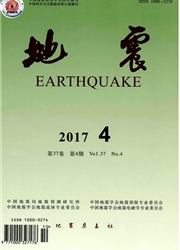

 中文摘要:
中文摘要:
利用张家口—渤海断裂带(张渤带)及其邻区1999—2007年的GPS观测数据,研究了该区域现今地壳水平速度场特征。运用最小二乘配置方法获得应变率场的空间分布特征,根据区域地壳主应变率、面膨胀率和最大剪切应变率等形变场的空间变化,分析了张渤带各分段的形变特征。结果表明:相对于欧亚框架,研究区内GPS速度场以SE方向运动为主;应变场以NE方向的主压应变为主,伴随着近NW方向的张性应变;整个张渤带及其邻区的高剪切变形区主要位于河北香河、文安以及唐山等三个地区。利用跨断层GPS剖面分析得到张渤带以左旋走滑为主,兼有挤压运动。华北平原块体和燕山块体的相对运动是张渤带左旋走滑的直接动力来源,而印度板块与欧亚板块碰撞后继续向北的推挤作用则是张渤带运动变形的根本动力来源,太平洋板块的作用相对较弱。
 英文摘要:
英文摘要:
With collected GPS data in the period of 1999~2007from the Crustal Motion Observation Network of China along the Zhangjiakou-Bohai fault and its adjacent regions,we study the characteristics of present-day crustal horizontal motion velocities in the research zone.Strain rate components are computed in spheric coordinate system with the least square collocation method.According to the spatial distribution of the principal strain rate,dilation rate and maximum shear strain rate derived from GPS measurements,we analyse the deformation of the subordinary faults of the Zhangjiakou-Bohai fault.The principal compression strain rates are apparently greater than principal extension strain rates.The larger shear strain rates mainly distribute in and around the areas of Xianghe,Wenan,and Tangshan in Hebei Province.According to the profiles across different segments of the Zhangjiakou-Bohai fault,the three segments along the Zhangjiakou-Bohai fault show an obviously left-lateal strike slip and compression characteristics.By analysing the motion characteristics of the blocks,Yanshan block,North China Plain block,Ordos block,and Ludong-Huanghai block in and around the North China,we spectulate that the dynamics of the motion styles of Zhangjiakou-Bohai fault may directly come from the relative movement between the Yanshan block and the North China plain block,and the ultimately dynamics may be the results of the collison between Indian plate and Eurasian plate,and the persistent northeastward movement of the Indian plate.
 同期刊论文项目
同期刊论文项目
 同项目期刊论文
同项目期刊论文
 期刊信息
期刊信息
